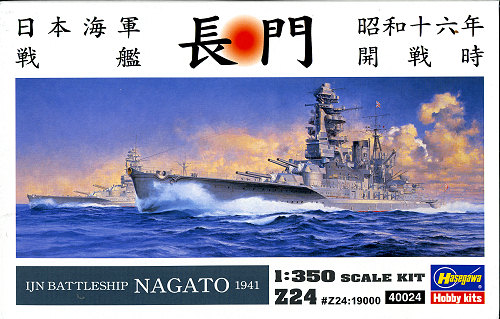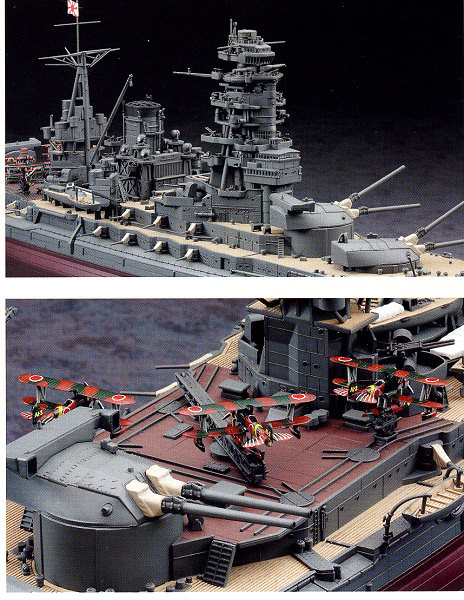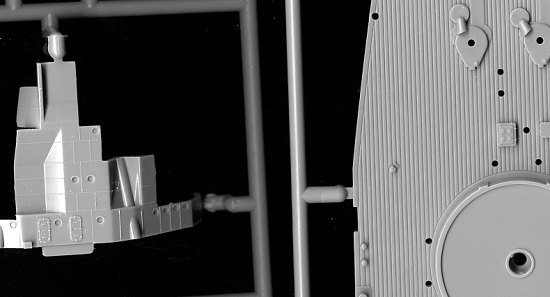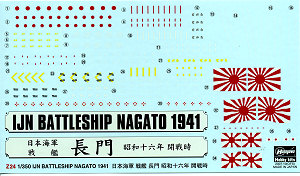
| KIT: | Hasegawa 1/350 Battleship Nagato (1941) |
| KIT #: | 40024 |
| PRICE: | $210.00 MSRP |
| DECALS: | Many options |
| REVIEWER: | Scott Van Aken |
| NOTES: | Full hull |

| HISTORY |
Nagato (Japanese: 長門, named after Nagato province) was a battleship of the Imperial Japanese Navy, the lead ship of her class. She was the first battleship in the world to mount 16 inch (406 mm) guns, and her armour protection and speed made her one of the most powerful capital ships at the time of her commissioning in 1920
At the outbreak of World War II, Nagato, under the command of Captain Yano Hideo, and her sister ship Mutsu formed Battle Division 1. Nagato was the flagship of the Combined Fleet, flying the flag of Admiral Yamamoto Isoroku. On 2 December 1941 Nagato sent the signal Niitakayama nobore 1208 "Climb Mount Niitaka on 12/08 (Japanese Time)" that committed the Carrier Strike Force to the attack on Pearl Harbor and Japan to the Pacific War.
On 12 February 1942 Admiral Yamamoto transferred his flag to the new battleship Yamato.
Nagato sailed with the Yamato, Mutsu,Hosho, Sendai, nine destroyers and four auxiliary ships as Admiral Isoroku Yamamoto's Main Body during the Battle of Midway in June 1942 but saw no action. She returned the survivors of Kaga to Japan.
In 1943, under the command of Captain Hayakawa Mikio,Nagato was based at Truk in the Caroline Islands. After the evacuation of Truk in February 1944, she was based at Lingga near Singapore.
In June 1944 she took part in Operation A-Go, an attack on Allied forces in the Mariana Islands. In the battle of the Philippine Sea on 19 June 1944 she came under air attack but was not damaged.
In October 1944 she took part in Operation Shō-1, an attack on the Allied landings on Leyte. On 24 October 1944 in the battle of the Sibuyan Sea Nagato was attacked by several waves of American dive-bombers. At 14:16 she was hit by two bombs dropped by planes from Franklin and Cabot. The first bomb disabled a number of guns and damaged the air intake to the No. 1 boiler room, stopping one shaft for 25 minutes until the air intake was cleared. The second bomb hit the canteen and forward radio room, killing 52 and wounding 106. On 25 October the Central Force passed the San Bernardino Strait and headed for Leyte Gulf. In the battle off Samar, Nagato engaged the escort carrier and destroyers of the US Task Group 77.4.3. At 06:01 she opened fire on St. Lo, the first time she fired her guns at an enemy ship, but missed. At 06:54 the destroyer Heermann fired a spread of torpedoes at Haruna; the torpedoes missed Haruna and headed for Yamato and Nagato on parallel courses. The two battleships were forced to turn away from the action to the north for 10 miles (16 km) until the torpedoes ran out of fuel. After returning to the action, Nagato continued to engage the American carriers, firing 45 16 inch (406 mm) shells and 92 5.5 inch (140 mm) shells.
At 09:10 Admiral Takeo Kurita ordered the fleet to break off the engagement and head north. At 10:20 he ordered the fleet south again, but as the fleet came under increasingly severe air attack he ordered a retreat again at 12:36. At 12:43 Nagato was hit on her bow by two bombs but the damage was not severe.
As it retreated on 26 October the Japanese fleet came under continuous air attack. Nagato was attacked by dive-bombers from Hornet and hit by four bombs, suffering 38 killed and 105 wounded. In the course of the day she fired 99 16 inch (406 mm) shells and 653 5.5 inch (140 mm) shells.
On 25 November 1944 Nagato arrived at Yokosuka, Japan for repairs. Lack of fuel and materials meant that she could not be brought back into service, and in February 1945 she was reassigned as a coastal defence ship. In June 1945 her secondary and anti-aircraft armament were moved ashore. On 18 July 1945 she was attacked at Yokusuka by fighter bombers and torpedo bombers from Essex, Randolph, Bennington, Shangri-La and Belleau Wood and hit by three bombs, one hitting the bridge and killing her commanding officer, Rear Admiral Otsuka Miki.
On 30 August 1945, following the Japanese surrender, Nagato, the last active Japanese battleship, was boarded and secured by American sailors from the ship USS Horace A. Bass (LPR-124).
In March 1946 she was taken to Bikini Atoll for Operation Crossroads, a series of atomic bomb tests. On this, her last voyage, she was commanded by Captain W. J. Whipple with a United States Navy crew of about 180 men. She was in such poor repair that on the way she had to be towed to Eniwetok Atoll for emergency repairs.
In the first test (ABLE, an airburst) on 1 July 1946 she was 1,640 yards from ground zero and was not severely damaged. In the second test (BAKER, an underwater explosion) on 25 July 1946 she was severely damaged, and eventually capsized and sank five days later.
| THE KIT |
 This kit was a pretty major surprise to me as few knew it was coming. It is the first really big ship kit that Hasegawa has done in decades and follows several recent ship releases in this scale. Each of these newer release models have been 'lucky' ships that have either survived the war or some other major catastrophe (as did the icebreaker kit released earlier this year).
This kit was a pretty major surprise to me as few knew it was coming. It is the first really big ship kit that Hasegawa has done in decades and follows several recent ship releases in this scale. Each of these newer release models have been 'lucky' ships that have either survived the war or some other major catastrophe (as did the icebreaker kit released earlier this year).
Those are all minor ships when compared to the Nagato.
With nearly 850 pieces this is not a kit for the faint of heart nor one that can be built properly in less than a few months. Basically it is a most complete kit, though I'm sure there are several photo-etch set makers already busy doing a set of ladders and railings for this one. The kit has a two piece hull that has a full set of ingeniously done bulkheads for the inside that have sturdy peg and hole mountings. No worries of a warped deck or any other similar problems with this kit. This reinforcement set-up also extends to some of the more distant superstructure parts. This internal bracing is throughout the superstructure. On the upper section of these reinforcements are tabs into which the decks will fit, making for a very tight fit.
 As this is the 1941 fit, we can expect there to be holes in the decks for earlier and later fittings and so it is with this one. Each of the guns has blast bags molded in place and can be elevated if one wishes. Several small 'Dave' float planes are included for spotting. A large clear sprue is provided for bridge windows,
As this is the 1941 fit, we can expect there to be holes in the decks for earlier and later fittings and so it is with this one. Each of the guns has blast bags molded in place and can be elevated if one wishes. Several small 'Dave' float planes are included for spotting. A large clear sprue is provided for bridge windows,  running light, spotlight lenses, rangefinder windows, and the like. There is also a section of chain for the anchor chains. Apparently most of the guns of all sizes are designed to move in either azimuth or elevation as the extremely comprehensive instructions show a lot of 'do not glue' markings relating to them.
running light, spotlight lenses, rangefinder windows, and the like. There is also a section of chain for the anchor chains. Apparently most of the guns of all sizes are designed to move in either azimuth or elevation as the extremely comprehensive instructions show a lot of 'do not glue' markings relating to them.
A quite large decal sheet is included which includes general markings as well as insignia for the planes, flags and name tag decals. In addition, there is a sheet of paper flags in case one wishes to dress the ship.
| CONCLUSIONS |
I'm sure that ship fans will be quite pleased with this kit. It is superbly molded and a kit of a ship that has not been molded in this scale before. We can only hope that this will not be the last as it really is a beauty. Not sure how available it will be so you may want to grab one when the opportunity presents itself. This kit is now on its way to being built so stay tuned to see how it turns out.
| REFERENCES |
November 2007 My thanks towww.dragonmodelsusa.com for the review kit. Get yours at your local retailer of ask them to order one for you. If you would like your product reviewed fairly and fairly quickly, please contact the editor or see other details in the Note to Contributors.